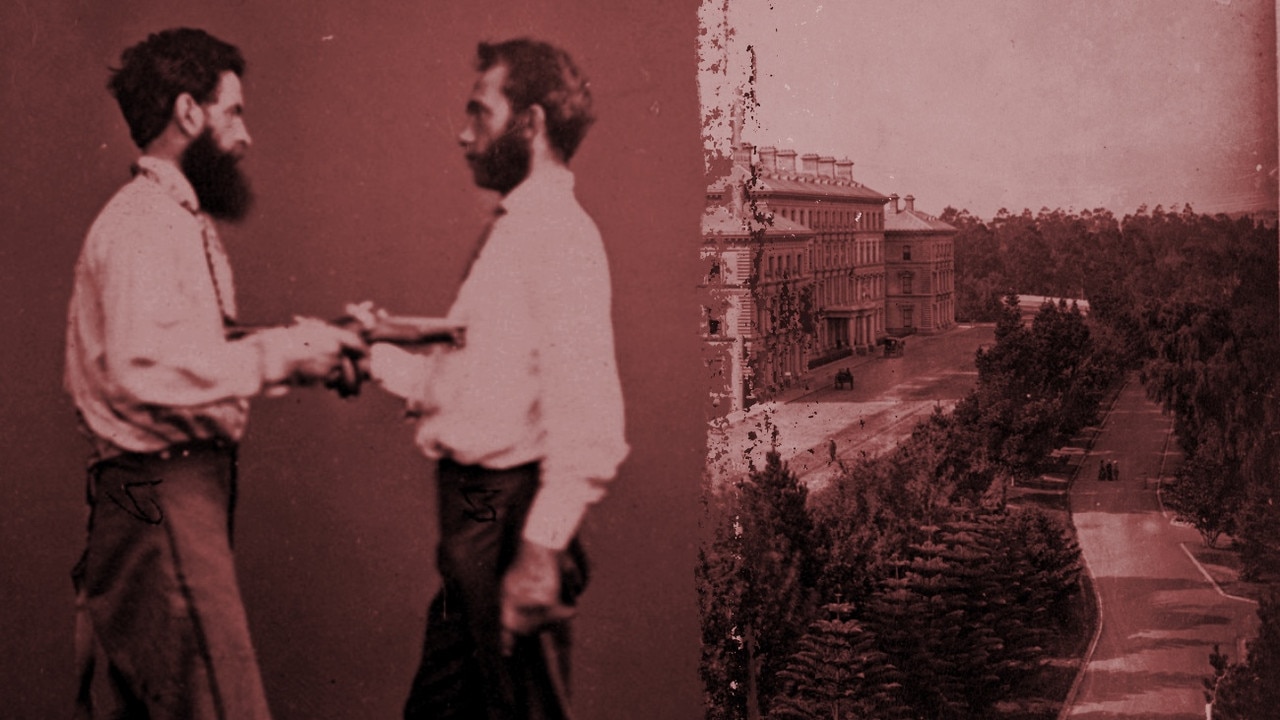Pre-gold rush Melbourne: take a look at the city’s oldest buildings
YOU may walk past these places every day and not even realise they are the city’s oldest. These are Melbourne buildings that are more than 160 years old.
Melbourne
Don't miss out on the headlines from Melbourne . Followed categories will be added to My News.
MELBOURNE was a crude settlement in 1835.
It grew to only 23,000 people in its first 15 years.
In July 1851, Victoria separated from New South Wales and gold was discovered a few months later — causing the population of the state to explode.
By 1860, the population of Victoria was 700,000 — and the city’s new found wealth resulted in a redevelopment of the city — with many of the pre-gold rush buildings torn down.
Take a walk through Melbourne and discover buildings with links to the pre-gold rush days that managed to survive as Marvellous Melbourne boomed around them.
St James’ Old Cathedral
THE oldest building originally built in Melbourne is St James Old Cathedral which was built in 1839 on the corner of Collins and William streets — and later relocated to King Street in 1914.
Mr Robert Russell, a London architect and surveyor, designed the building, which is made from bluestone and sandstone.
The foundation stone was laid by Charles La Trobe, Superintendent of the District of Port Phillip, on the 9th November 1839.
La Trobe had also brought a gift from Queen Victoria to the new colony, a baptismal font from St Katherine’s Abbey in London, which remains the font at St James’ today.



On the 29th June 1847, Charles Perry was consecrated in Westminster Abbey in London as Melbourne’s first bishop. He returned to Melbourne and was enthroned at St James’ on January 28, 1848 and it became the Cathedral church of the new diocese of Melbourne.
When Melbourne was booming and one of the wealthiest cities in the world in the 1880s, St Paul’s Cathedral was built and St James’ lost the title of Cathedral and became a parish church.
It was hardly being used in the early 20th Century, and plans were made for it to be demolished, but people protested and it was eventually decided to relocate it to another location.
The church was moved stone-by-numbered-stone to a new site on King Street, opposite Flagstaff Gardens and reopened in 1914.
Minor changes were made during the rebuilding, most noticeably to the third level of the bell tower which became square instead of octagonal.

300 Queen Street
THE former residence at 300 Queen Street is one of the oldest surviving houses in the central city area.
The beautiful Georgian building was designed in 1848 and built between 1849 and 1852 for one of Melbourne’s earliest settlers, J T Smith — a publican and theatre entrepreneur who was Mayor of Melbourne seven times during the 1850s and 1860s.


The house was next occupied by David Munro between 1879 and 1889 — a successful railway contractor and land speculator who was bankrupted during the economic crash of the early 1890s.
300 Queen Street is a rare surviving example of the simple but elegant Georgian design by two of Melbourne’s earliest architects, Charles Laing and David Ross.
The building is now part of Victoria University.

Job Warehouse (Crossley’s Building)
JOB Warehouse is one of only a handful of surviving buildings in central Melbourne dating from before the first gold rushes.
It was build in 1848-49 as a two storey row of brick shops that stretches from Crossley Street to Liverpool Street.
It remains mostly as it appeared when first constructed, except for the shop windows and some minor changes to the facade.
The part of the building at 60-62 Bourke Street was built by a well-known butcher William Crossley as a shop, slaughter yard and residence.
The Crossleys trained many of Melbourne’s leading butchers in the 1880s.
Distinguished landscape painter Eugene von Guerard also lived in no. 56 in 1857 and 1858, one of Australia’s leading colonial artists who helped establish the Victorian Society of Fine Arts.


Former Black Eagle Hotel
THE former Black Eagle Hotel is the oldest surviving building in the former red light district once known as “Little Lon”.
It was built in 1850 by William Kennon as a pair of two-storey bluestone and brick houses, but was probably used as a hotel from the beginning — though it was not described as such until 1853.

The building was listed officially as a pub in 1853 and the first licensee was William Brandt, who held it until 1858, when Kennon took over the license until the hotel was purchased by the Melbourne Brewing and Malting Company in 1882.
The pub would have been busy and profited greatly from the activity at the infamous Madame Brussel’s brothel, which was two doors along the street.
The pub closed down in 1908, along with many others in the city, following the Licenses Reduction laws of 1906, and after this was home to various businesses.
It was a lodging house for some years and from 1918 was occupied by a Chinese cabinet maker, W H Chinn.


In 1919 the property was purchased by the printer Joshua McClelland who in 1920 built a large single-storey brick printing shed at the rear and operated it as a printing business until 1977.
The building has been restored and is now used as a shop on the ground floor with storage and office space above.
The rear facade is incorporated into the new office building called 50 Lonsdale.
There are remnants of early twentieth century painted signs on the corner of the building, and internally some original floor and ceiling joists remain.
Some of the walls are lined with illustrations taken from nineteenth century newspapers and magazines which is covered by was mid-to-late-Victorian wallpaper, now partly burnt off.

Oddfellows Hotel

THE former Oddfellows Hotel is one of the oldest surviving buildings in the City of Melbourne.
It is significant for its association with Melbourne’s Little Lon district, home to the city’s poorest residents and many immigrant groups, particularly the Chinese.
During the nineteenth and early twentieth centuries the area was notorious for its poverty, crime and prostitution.
The Oddfellows Hotel was constructed in stages between 1848 and 1853, started by carpenter Henry Charles Wills, who built a single storey cottage with a carpenter’s yard for himself.
He then built a large house with a cellar and 15 rooms — part of which became the Oddfellows Hotel.
The hotel lost its license along with many others in the city with the Licenses Reduction laws of 1906 and closed in 1912.
After the hotel closed the whole building became a furniture manufacturing workshop and in 1914 the property was bought by the well-known merchant Cheok Hong Cheong, a missionary and social reformer in the Chinese quarter of Melbourne.

The building was occupied by Chinese cabinet makers until 1948 when it was acquired by the Commonwealth Government.
The building was restored in the 1990s with the interior rearranged for commercial use, and in 2005-06 an extension was added at the rear and the interiors were largely gutted as part of its conversion to a bar and restaurant.
The building’s original facade is largely intact, and it is a now rare demonstration of the commercial buildings once common in the city.

Cook’s Cottage

This inclusion may be contentious — but the oldest building in Melbourne is technically Cook’s Cottage in the Fitzroy Gardens.
The house was built by Captain James Cook’s father in 1755 in Great Ayton in England, and in 1933, the last owner of the cottage, Mrs. Dixon put it up for sale.
It was suggested that it would make an ideal focus piece for Victoria’s centenary in 1934, and wealthy Melburnian Russell Grimwade puts plans in motion to secure it as a centenary gift for the state of Victoria.
Mrs Dixon wanted the cottage to remain in Britain and had rejected offers from wealthy Americans, but she was eventually persuaded by Grimwade on the premise that Australia was still “in the Empire”.

In 1934 it was moved brick-by-brick from Great Ayrton to Melbourne, shipped in 253 crates complete with an ivy cutting which had grown on the original building.
Today the cottage is covered by the same original ivy.
The site in Fitzroy Gardens was selected and construction work was completed in six months — when the cottage was handed over to the Lord Mayor H. Gengoult Smith by Russell Grimwade on the 15th October, 1934.
The cottage has undergone two restorations. The first in the late 1950s and the most recently in 1978, when it was decorated with period furniture and surrounded by an 18th Century style garden.
Captain James Cook never actually lived in the house but it’s thought he would have visited his parents there from time-to-time — or at least we hope he did.
The cottage was vandalised in 2014 and the exterior was spray painted with “26th Jan Australia’s shame”.

FURTHER READING:THE HISTORY OF THE YARRA RIVER
FURTHER READING: A LOOK BACK AT MEBOURNE’S ICONIC TRAMS
FURTHER READING: THE SITES THAT SHAPED THE CITY’S HISTORY


